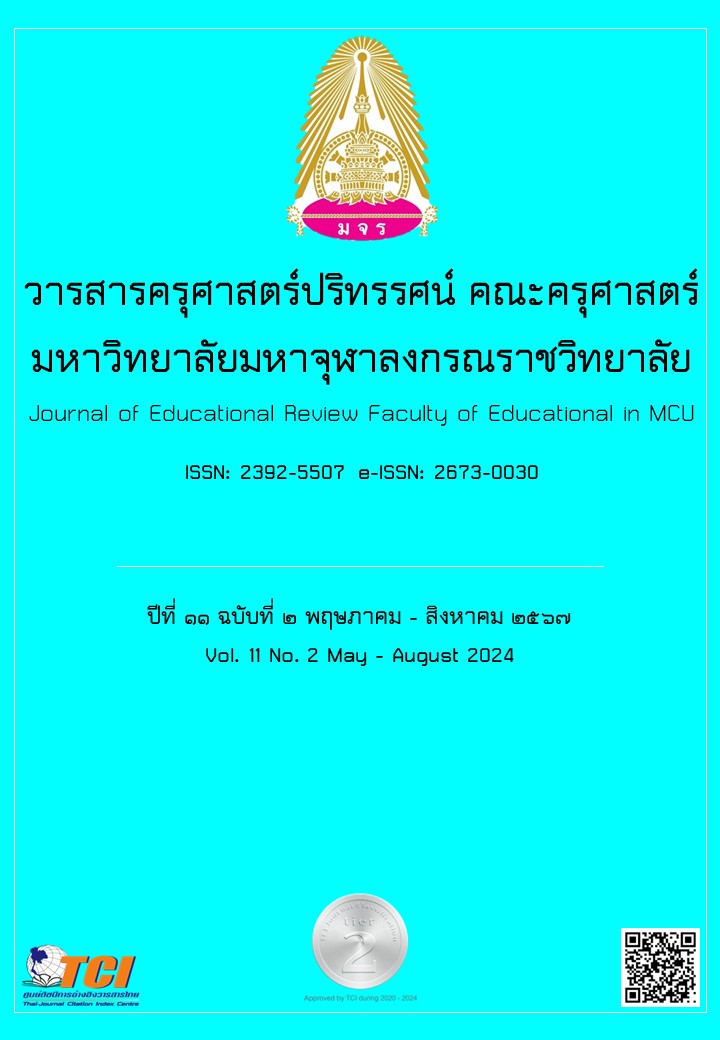GUIDELINES FOR THE ADMINISTRATION LEARNING RESOURCES MANAGEMENT BASED ON BAHUSUTA OF SCHOOLS
Main Article Content
Abstract
This research article aimed to 1) study the management of learning resources in secondary schools in the Office of the Secondary Education Service Area, Saraburi; 2) compare teachers’ opinions on learning resources in schools according to their work experience, education level, gender, job position, and personal characteristics, and 3) propose a guideline for managing learning resources in schools according to the principle of polymath using a mixed-method research methodology. The quantitative research method collected data from a sample of 297 people. The research instrument was a questionnaire with a reliability of .63. Data were analyzed by finding frequency, percentage, mean, and standard deviation. The hypothesis of comparison was tested by using the F-test and one-way analysis of variance. Semi-structured interviews were used to collect data from 9 key informants and analyzed by content analysis. The research results found that 1) The management of learning resources in secondary schools as a whole and in each of the 5 aspects was at a high level. 2) The results of comparing teachers’ opinions on the management of learning resources in schools according to the principle of polymath were tested by analyzing the differences between variables, namely, classification by gender, education level, job position, and work experience, which showed different opinions on the management of learning resources in schools according to the principle of polymath. Overall, there was no statistically significant difference. 3) The guidelines for school learning resource management according to the principle of polymath are as follows: (1) Planning for learning resource management, administrators should have a careful and clear plan, set a budget for learning resource study for teachers. (2) Personnel management, school administrators should have good human relations principles that are essential for relying on others, assigning appropriate tasks to individuals. (3) Management, administrators should manage and support learning resources appropriately by organizing a variety of activities that were conducive to learning resource users. (4) Development and use of learning resources, school administrators should have clear development principles, have a plan, implement projects to create and develop learning resources systematically. (5) Summarizing and reporting the results of learning resource creation and development, administrators must learn from what they have learned, whether it was planning and managing learning resources systematically that could solve problems.
Article Details

This work is licensed under a Creative Commons Attribution-NonCommercial-NoDerivatives 4.0 International License.
ทัศนะและความคิดเห็นที่ปรากฏในบทความในวารสารฉบับนี้ถือเป็นความรับผิดชอบของผู้เขียนบทความนั้นเพียงผู้เดียว และไม่ถือเป็นทัศนะและความรับผิดชอบของกองบรรณาธิการ
กองบรรณาธิการขอสงวนสิทธิ์ในการคัดเลือกบทความลงตีพิมพ์และจะแจ้งให้เจ้าของบทความทราบหลังจากผู้ประเมินบทความตรวจอ่านบทความแล้ว
ต้นฉบับที่ได้รับการตีพิมพ์ในวารสารครุศาสตร์ปริทรรศน์ คณะครุศาสตร์ มหาวิทยาลัยมหาจุฬาลงกรณราชวิทยาลัย ถือเป็นกรรมสิทธิ์ของคณะครุศาสตร์ มหาวิทยาลัยมหาจุฬาลงกรณราชวิทยาลัย ห้ามนำข้อความทั้งหมดหรือบางส่วนไปพิมพ์ซ้ำ เว้นเสียแต่ว่าจะได้รับอนุญาตจากมหาวิทยาลัยฯ เป็นลายลักษณ์อักษร
References
ธานินท์ ศิลป์จารุ. (2551). การวิจัยและวิเคราะห์ ข้อมูลทำงสถิติด้วย spss. พิมพ์ครั้งที่ 9. กรุงเทพมหานคร: สำนักพิมพ์บิสซิเนสอาร์แอนด์ดี.
นงเยาว์ อุทุมพร. (2561). การบริหารจัดการแหล่งเรียนรู้ของชมชนตามหลักเศรษฐกิจพอเพียงเพื่อนําไปใช้บูรณาการในการจัดการเรียนรู้ในสถานศึกษาอย่างยั่งยืน อำเภอบางพลี จังหวัดสมุทรปราการ. รายงานการวิจัย. มหาวิทยาลัยราชภัฏธนบุรี.
พระพรหมคุณาภรณ์ (ป. อ. ปยุตฺโต). (2551). พจนานุกรมพุทธศาสตร์ ฉบับประมวลศัพท์. กรุงเทพมหานคร: ธนธัชการพิมพ์.
พระพรหมคุณาภรณ์ (ป. อ. ปยุตฺโต). (2551). พจนานุกรมพุทธศาสตร์ ฉบับประมวลธรรม. พิมพ์ครั้งที่ 16. กรุงเทพมหานคร: เอส. อาร์. พริ้นติ้ง แมส โปรดักส์.
มงคล พลภูมี. (2555). สภาพการดำเนินงานพัฒนาแหล่งเรียนรู้ของสถานศึกษา สังกัดสำนักงานเขตพื้นที่การศึกษาหนองคาย เขต 1. วิทยานิพนธ์ครุศาสตรมหาบัณฑิต มหาวิทยาลัยราชภัฏมหาสารคาม.
มหาจุฬาลงกรณราชวิทยาลัย. (2539). พระไตรปิฎกภาษาไทย ฉบับมหาจุฬาลงกรณราชวิทยาลัย. กรุงเทพมหานคร: มหาจุฬาลงกรณราชวิทยาลัย.
รวิพร มูณีวรรณ. (2554). การใช้แหล่งเรียนรู้ในชุมชนประกอบการจัดการเรียนรู้ของครูในสถานศึกษาขั้นพื้นฐาน สังกัดสำนักงานเขตพื้นที่การศึกษา นครศรีธรรมราช เขต 1. วิทยานิพนธ์ครุศาสตรมหาบัณฑิต. มหาวิทยาลัยราชภัฎนครศรีธรรมราช.
ศิริญาภา ทองมะหา และคณะ. (2562). แนวทางการจัดการเรียนการสอนวิชาวิทยาศาสตร์ตามหลักพหูสูต 5 ของโรงเรียนในเครือข่ายที่ 49 สำนักงานเขตคลองสามวา กรุงเทพมหานคร. วารสารครุศาสตร์ปริทรรศน์ คณะครุศาสตร์ มหาวิทยาลัยมหาจุฬาลงกรณราชวิทยาลัย. 6(1). 28-38.
สำนักงานคณะกรรมการการศึกษาแห่งชาติ. (2545). พระราชบัญญัติการศึกษาแห่งชาติ พ.ศ. 2542 และที่แก้ไขเพิ่มเติม (ฉบับที่ 2) พ.ศ. 2545. กรุงเทพมหานคร: พริกหวานกราฟฟิค.
Keeves, Peter J. (1988). Model and Model Building: Educational Research Methodology and Measurenment : An Intermational Handbook. Oxford: Pergamon Press.
Krejcie, R. V. & Morgan, D. W. (1970). Determining sample size for research activities. Educational and Psychological Measurement. 30(3). 607–610.


